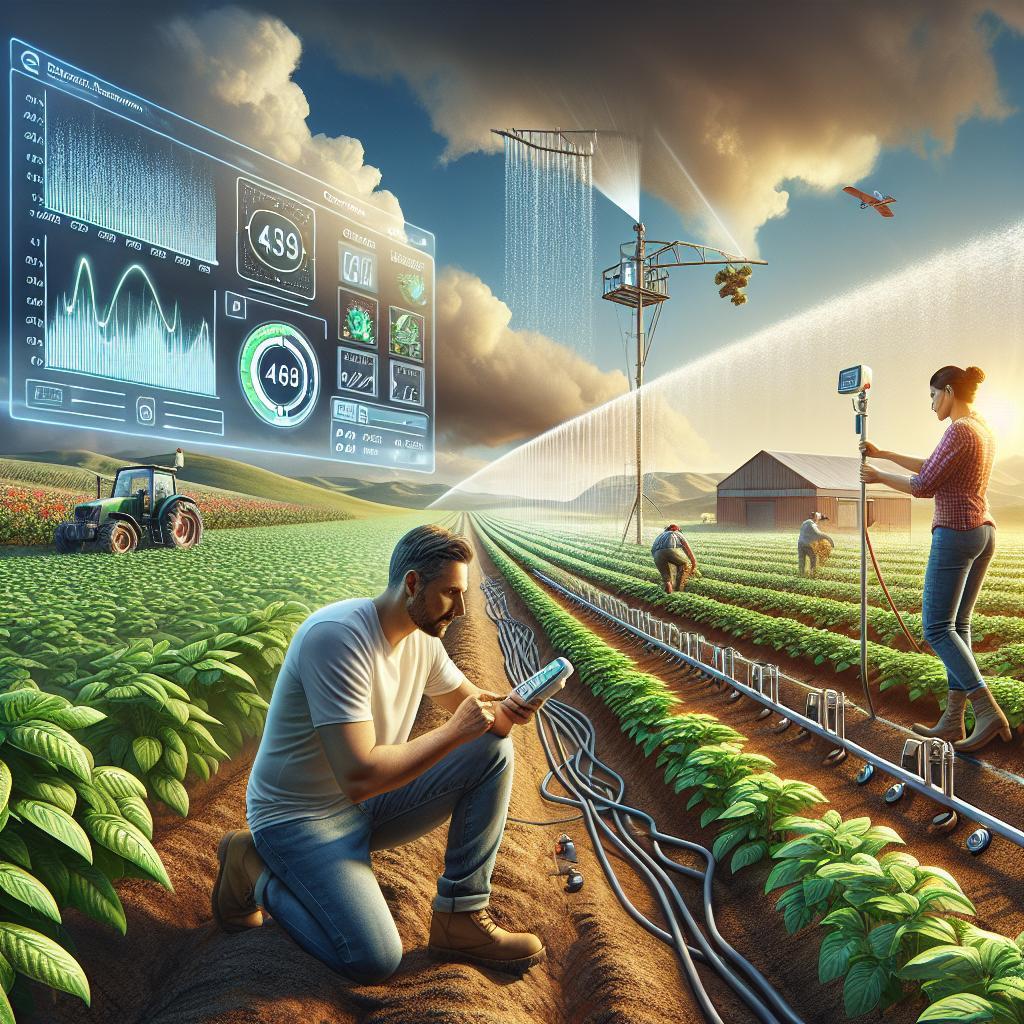This post may contain affiliate links which means I may receive a commission for purchases made through links. Learn more on my Private Policy page.
Unlocking the Secrets of Soil: Your Amiable Guide to Effective moisture Monitoring in Farm Irrigation
In the vibrant tapestry of agriculture, where every drop of water counts, understanding your soil is key to nurturing robust crops and ensuring a bountiful harvest. Picture this: you’re standing in the golden glow of your fields, the sun casting warm shadows, yet your mind is occupied with thoughts of moisture levels hidden beneath the surface. Is the soil too dry? Too wet? The balance is delicate, but fear not—embracing effective moisture monitoring can transform your farming game!
In this article, we’re here to demystify the world of moisture monitoring with friendly tips and practical insights to help you master the art of irrigation. Whether you’re a seasoned farmer or just starting your journey, our guide will empower you to make informed decisions that enhance crop health, conserve water, and boost productivity. So grab your favorite beverage, settle in, and let’s dive into the wonderful world of soil moisture—where precision meets passion, and every farm can flourish!
Understanding Soil Moisture Dynamics for Optimal Crop Health
Understanding the behavior of moisture in the soil is crucial for maintaining healthy crops. it is essential to recognise that soil moisture levels fluctuate based on several factors,including rainfall,evaporation rates,and plant uptake. Monitoring these dynamic changes helps in regulating irrigation practices, ensuring plants receive the right amount of water at the right time. Here are some effective strategies for moisture monitoring:
- Utilize Soil Moisture Sensors: these advanced tools provide real-time data on soil moisture levels,allowing farmers to make informed decisions.
- Implement a Scheduling System: Develop a schedule based on weather patterns and crop needs, adjusting irrigation times accordingly.
- Visual Inspection: Regularly check the soil’s surface and root zone for signs of dryness or excess water.
- Consider Soil Type: Diffrent soils retain moisture differently; know your soil for accurate water management.
In addition to these strategies, visualizing data through tables and graphs can enhance understanding and decision-making regarding irrigation practices. For example, tracking total rainfall against irrigation application over a growing season can be beneficial. Consider maintaining a simple table like the one below to efficiently monitor these key metrics:
| Month | Total Rainfall (inches) | Irrigation Applied (inches) |
|---|---|---|
| January | 3.5 | 1.0 |
| february | 2.0 | 1.5 |
| March | 1.2 | 2.0 |

Choosing the Right Tools for Accurate Soil Moisture Measurement
For effective soil moisture measurement, selecting the right tools is essential. Various options are available, each tailored to specific needs and budget constraints. consider the following equipment:
- Soil Moisture Sensors: These devices provide real-time data on moisture levels, allowing you to adjust irrigation schedules promptly.
- Tensiometers: With a focus on measuring the tension of water in the soil, these tools help gauge when plants are thirsty.
- Capacitance Probes: Using electrical resistance, these probes offer precise data on soil moisture content across different depths.
When choosing your soil moisture measurement tools, it’s critically important to think about the scale of your operation and the specific crops you are growing. Key factors to consider include:
- Durability: ensure the equipment is built to withstand tough farm conditions.
- Data Compatibility: Check if the tools can integrate with your existing farm management systems.
- Cost-Effectiveness: Balance your budget with the desired accuracy and features.

timing is Everything: Mastering Irrigation Schedules with Data
In the world of agriculture, precision in irrigation not only conserves vital resources but also enhances crop yield. Tracking soil moisture levels is key to creating an efficient watering schedule. start by utilizing data-driven tools to monitor moisture content, allowing you to adapt your irrigation practices to the specific needs of your crops.Here are some practical techniques to consider:
- Install Soil Moisture Sensors: These devices provide real-time data, enabling farmers to identify when soil saturation reaches optimal levels.
- Use Evapotranspiration (ET) Rates: Understanding the water loss from soil and plants can help you predict when to irrigate.
- Analyze Historical Weather Data: keeping track of rainfall and temperature patterns can refine your irrigation plan.
moreover, combining these methods with regular assessments enhances your ability to make informed decisions about irrigation scheduling. Consider creating a simple table to visualize your moisture data over time,which can help spot trends and avoid over or under-watering.
| Date | Soil Moisture Level (%) | Recommended Irrigation (mm) |
|---|---|---|
| 2023-10-01 | 25 | 10 |
| 2023-10-08 | 30 | 5 |
| 2023-10-15 | 20 | 15 |
By regularly updating this table and analyzing the data, you can maintain optimal irrigation practices and cultivate the healthiest crops possible. Remember, the secret to thriving agriculture lies in understanding the relationship between moisture, timing, and crop demands!

Building a Moisture Monitoring Routine: Tips for Consistency and Success
Establishing a consistent moisture monitoring routine is pivotal for optimizing farm irrigation and achieving a successful yield. Begin by investing in reliable moisture sensors that can provide real-time data, allowing you to make informed decisions for your crops.It’s also beneficial to set up a regular schedule for readings, ensuring that you check moisture levels at the same time each day or week, depending on your crop’s needs. This creates a habit that not only simplifies your workflow but also helps you recognize patterns and anticipate irrigation requirements more accurately.
In addition to daily readings, consider utilizing a simple tracking system, such as a spreadsheet, to log moisture levels and correlate them with weather patterns, soil types, and crop growth phases. this repository of information can significantly enhance your understanding of moisture behavior in different conditions. Here are some key factors to monitor:
- Weather conditions: Note rainfall and temperature changes.
- Soil type: Familiarize yourself with how different soils retain moisture.
- Crop types: Different crops may have varied moisture needs.
- Irrigation methods: Adjust strategies based on efficiency and efficacy.
| Monitoring Aspect | Frequency | Action |
|---|---|---|
| Soil Moisture readings | Daily | Adjust irrigation accordingly |
| Weather Data Review | Weekly | Plan for rain and adjust schedules |
| Sensor Calibration | Monthly | Ensure accuracy of readings |
Final Thoughts
As we wrap up our exploration of moisture monitoring for farm irrigation, let’s remember that every drop of water counts! By implementing these tips, you’re not just nurturing your crops; you’re also nurturing the planet. Think of moisture monitoring as your trusty compass in the vast sea of farming challenges—guiding you to enduring practices while maximizing yields.
So grab your moisture sensors and make them your partners in crime! With a sprinkle of technology and a dash of diligence, you can cultivate a thriving landscape that’s both productive and planet-friendly. Happy farming, and may your fields flourish under the watchful eyes of your new moisture-monitoring friends! 🌱💧
This post may contain affiliate links which means I may receive a commission for purchases made through links. Learn more on my Private Policy page.

